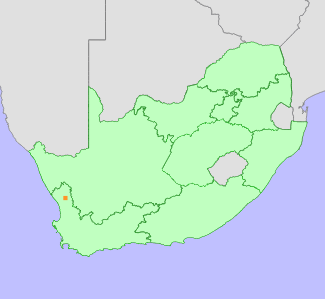|
Scientific Name | Conophytum uviforme (Haw.) N.E.Br. subsp. subincanum (Tischer) S.A.Hammer |
Higher Classification | Dicotyledons |
Family | AIZOACEAE |
Synonyms | Conophytum subincanum Tischer |
National Status |
Status and Criteria | Vulnerable A4d; B1ab(v) |
Assessment Date | 2021/12/10 |
Assessor(s) | A.J. Young, P.G. Desmet, I. Ebrahim, D. Guo, A. Harrower, L. Jabar, L. Knoetze, D. Raimondo, C. Rodgerson, P.C.V. Van Wyk & N.N. Mhlongo |
Justification | This dwarf succulent is endemic to the Western Cape of South Africa with an extent of occurrence (EOO) and area of occupancy (AOO) of 12 km2. The population is in decline due to the illegal ornamental succulent plant trade, with collection likely to increase as there has been a dramatic increase in the number of species and volume of plants targeted since 2019. The continued threat of illegal collection is therefore regarded as high for this particular taxon.
The restricted geographic distribution, single location and small population size is likely to result in a decline of up to 90% of the population within the next three generations (60 years). It therefore qualifies as Critically Endangered under criteria A4 and B1. |
Distribution |
Endemism | South African endemic |
Provincial distribution | Western Cape |
Range | This succulent is endemic to the Western Cape of South Africa where it is only found in a single location with a severely restricted geographic range. |
Habitat and Ecology |
Major system | Terrestrial |
Major habitats | Knersvlakte Quartz Vygieveld |
Description | This taxon is endemic to the Knersvlakte bioregion of the Succulent Karoo biome. The plants occupy, and sometimes fill, seams or crevices in greyish limestone.
This taxon appears to be shorter lived than other subspecies and has a generation length of 20 years. It is expected to be sensitive to the impacts of climate change as it does not disperse and while adapted to arid conditions, is dependent on limited seasonal rainfall. Species in the genus are sensitive to long periods of drought. Drought related mortality has been observed for other closely related taxa within the genus. |
Threats |
| Plants have been subject to illegal collection of mature individuals for the international trade in ornamental succulents since 2019. This taxon has been sought after by collectors and is highly likely to remain so in future. The single location and small population size means that this taxon is susceptible to collection and a decline of up to 90% of the population is likely within the next three generations (60 years).
There is no decline in habitat quality for this succulent as inferred by changes in vegetation cover determined from changes in Enhanced Vegetation Index (EVI) between 1984 and 2018 using Landsat data (Venter et al. 2020). Anthropogenic climate change is a long-term threat to this taxon. Climate models for the likely emission scenarios where emissions stay at present day levels (RCP 2.6) (Hausfather and Peters 2020) and worst case scenarios where emissions continue to increase during the 21st century (RCP 8.5) indicate that there will be a loss of suitable bioclimatic envelope of between 29% and 76% by 2080 for this taxon. Species in this genus have limited dispersal ability and migration to suitable habitats elsewhere is regarded as highly unlikely.
Mining has previously resulted in the highly localised loss of plants but this threat has now ceased. |
Population |
This is a highly localised, but locally common succulent with subpopulations consisting of thousands of plants. There are no formal estimates of population size but there are likely between 5,000 and 10,000 mature individuals. Many of the plants confiscated by the authorities in South Africa have only been identified to species level so all the subspecies are treated the same here and this taxon is therefore believed to be experiencing initial levels of decline due to illegal collection for the international trade in ornamental succulents.
|
Population trend | Decreasing |
Assessment History |
Taxon assessed |
Status and Criteria |
Citation/Red List version | | Conophytum uviforme (Haw.) N.E.Br. subsp. subincanum (Tischer) S.A.Hammer | VU D2 | Raimondo et al. (2009) | | Conophytum uviforme (Haw.) N.E.Br. subsp. subincanum (Tischer) S.A.Hammer | VU D2 | Victor (2002) | |
Bibliography |
Hammer, S. 2002. Dumpling and his wife: New view of the genus Conophytum. EAE Creative Colour, Norwich.
Hammer, S.A. 1993. The genus Conophytum: A conograph. Succulent Plant Publications, Pretoria.
Hausfather, Z. and Peters, G.P. 2020. Emissions - the 'business as usual' story is misleading. Nature 577(618-620).
Opel, M.R. 2004. The rediscovery of Crassula alcicornis. Haseltonia 10:38-40.
Raimondo, D., von Staden, L., Foden, W., Victor, J.E., Helme, N.A., Turner, R.C., Kamundi, D.A. and Manyama, P.A. 2009. Red List of South African Plants. Strelitzia 25. South African National Biodiversity Institute, Pretoria.
Victor, J.E. 2002. South Africa. In: J.S. Golding (ed), Southern African plant Red Data Lists. Southern African Botanical Diversity Network Report 14 (pp. 93-120), SABONET, Pretoria.
|
Citation |
| Young, A.J., Desmet, P.G., Ebrahim, I., Guo, D., Harrower, A., Jabar, L., Knoetze, L., Raimondo, D., Rodgerson, C., Van Wyk, P.C.V. & Mhlongo, N.N. 2021. Conophytum uviforme (Haw.) N.E.Br. subsp. subincanum (Tischer) S.A.Hammer. National Assessment: Red List of South African Plants version 2024.1. Accessed on 2025/12/30 |
 Comment on this assessment
Comment on this assessment


